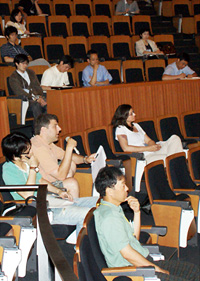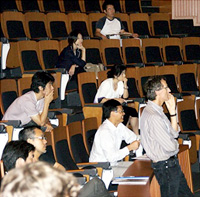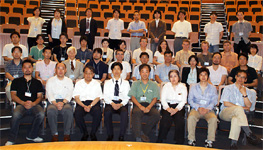

The Kawaguchi Team involved in the CREST research area of “Elucidation of the Principles of Formation and Function of the Brain Neural Network and Creation of Control Technologies” held the 5th International Neural Microcircuitry Conference, Tokyo JST session, "Microcircuitry of the Cortex" from June 29th (Tuesday) to the 30th (Wednesday), 2010, at the National Museum of Emerging Science and Innovation.
The local neural network that exists in the cerebral cortex has many types of nerve cells with very complicated input from and output to other areas: The system involved is yet to be understood. The CREST research area deals with this issue as its central theme. One of the best strategies to use in attempting to shed light upon the local neural system is a tight but collaborative approach being shared between researchers from the respective fields involved in the research. Sharing cutting-edge information from the respective fields is also essential in achieving the goal. For that purpose, and in addition to the CREST participant researchers, 16 neuroscience researchers from around the world, including Japan, gathered together at the Museum of Emerging Science and Innovation in Odaiba, Tokyo, to present and discuss the latest results of research on the neural systems of the cerebral cortex, hippocampus, and striatum for two days this summer. The total number of participants was 55: 13 from overseas (six countries that included the U.S.A., Germany, Austria, Australia, France, and China) and 42 Japanese researchers.
Nelson Spruston, Peter Jonas, and Greg Stuart all made presentations at the morning session on the first day on the analysis of depressor neurons in the cortical network. Every one of those presentations proved very interesting and the concept was considered quite novel and rather important. In the afternoon session some Japanese women researchers made their presentations: Fumino Fujiyama on the morphological characteristics of the nerve cells of the striatum and Yoko Sugiyama (Yazaki) on the development of depressor neurons based on experiences sensed in the visual cortex. Moreover, an American women researcher named Gina Turrigiano introduced an episode where the excitability of five-layered pyramidal cells decreased by monocular deprivation. After a recess Yoshikazu Isomura and Masanori Murayama, among others, introduced an in vivo neural activity. This was then followed the next morning by proposals of neural membrane potential imaging by Mutsuo Nuriya and the new concept of signal addition computation in dendrites from the two points of view of physiological experiments and theoretical analysis by Martlett Mel. Mazahir Hasan then explained a production method of and the possibility for new genetically-modified animals in an easy-to-understand manner. Sacha Nelson introduced an episode where the brain cortex of an animal lacking Mecp2, which is the causative gene of Rett syndrome, had considerably small amounts of synapse formations and less excitability. At the afternoon session Yousheng Shu presented some analysis on axon computation via multi-notch cells. Masanori Matsuzaki reported on some functional analysis of inhibitory input to pyramidal cells with the GABA encaging method and a 2-photon microscope, which can be expected to be focused upon as a possible new technique. Allan Gulledge made an interesting presentation on the importance of the existence of the spinous process using simulation analysis with model cells. Yoshiyuki Kubota, the final presenter, reported that he discovered three principles involving the form and size of the dendrites of non-pyramidal cells. All of them reported yet to be published data without any hesitation at all and many sharp questions were asked at the respective presentations: The conference proved to be very fruitful. The reputations of the participants were also very good: It proved to be an extremely high quality international research meeting.
As an aside we held a show involving ASIMO, the robot developed by Honda, at lunch time on the second day at the National Museum of Emerging Science and Innovation. All the participants were enchanted by the motions of ASIMO, which after all is a cutting-edge robot and as close to being a human being as possible, and which proved to be a brief respite from the conference.

JST, an integrated organization of science and technology in Japan, establishes an infrastructure for the entire process from the creation of knowledge to the return to the society. For more information, visit http://www.jst.go.jp/EN/